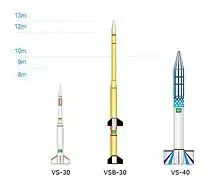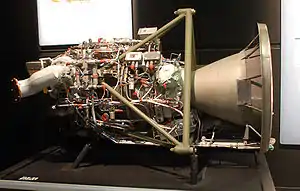VS-30
The VS-30 is a Brazilian sounding rocket, derived from the Sonda 3 sounding rocket's first stage.[1] It consists of a single, solid-fuelled stage, and has been launched from Alcântara, Maranhão, and Parnamirim, Rio Grande do Norte, in Brazil, and Andøya in Norway.
 | |
| Function | Sounding rocket |
|---|---|
| Manufacturer | Instituto de Aeronáutica e Espaço |
| Country of origin | Brazil |
| Size | |
| Height | 5 m (16.40 ft) |
| Diameter | 0.56 m (1.83 ft) |
| Mass | 1,400 kg (3,000 lb) |
| Stages | 1 |
| Launch history | |
| Status | Active |
| Launch sites | Alcântara Andøya Barreira do Inferno |
| Failure(s) | 1 |
| First flight | April 28, 1997 |
| First stage - S-30 | |
| Engines | 1 Solid |
| Thrust | 102.00 kN (22,930 lbf) |
| Burn time | 20 seconds |
| Propellant | Solid |
It has been launched both on its own, or in the VS-30/Orion configuration, with an American Orion upper stage.[2] On its own, it can reach an apogee of 140 kilometres,[1] and with an Orion upper stage, it can reach an apogee of 434 kilometres.[2] The VS-30 is also used as the upper stage of the VSB-30 rocket.
Flights[3]
VS-30
- VS-30 XV-01 -"DLR AL-VS30-223 test" - 1997 April 28 - Apogee: 128 km
- VS-30 XV-02 -"DLR AL-VS30-226" Aeronomy mission - 1997 October 12 - Apogee: 120 km
- VS-30 XV-03 -"DLR AL-VS30-229" Aeronomy mission - 1998 January 31 - Apogee: 120 km
- VS-30 XV-04 -"Operação São Marcos" Microgravity mission - 1999 March 15 - Apogee: 128 km
- VS-30 XV-05 -"Lençois Maranhenses" Microgravity mission - 2000 February 6 - Apogee: 148 km
- VS-30 XV-06 -"Cuma Microgravity mission" - 2002 December 1 - Apogee: 145 km
- VS-30 V07 -"Angicos GPS technology mission" - 2007 December 16 - Apogee: 120 km
- VS-30 V08 -"Operação Brasil-Alemanha" - 2011 December 2 - [4]
- VS-30 V09 - WADIS 1 - 28.06.2013
- VS-30 V10 - MAPHEUS 4 - 5.07.2013
- VS-30 V13 - EPL-MEL5 ("Estágio Propulsivo a Propelente Líquido") - "Operação Raposa"- 2014 September 1 - L5 liquid rocket engine test for 90s, total flight time 3m34s[5][6][7][8] - 2014 September 1
- VS-30 V11 - WADIS 2 - 2015 March 5 [3]
- VS-30 V12 - SPIDER / LEEWAVES - 2016 February 2 [3]
- VS-30 V124 - "Operação MUTITI" - 2018 September 12 - Apogee: 120 km[9]
VS-30 Orion
- VS-30 Orion - XV-01 - 21.08.2000 - "Baronesa"
- VS-30 Orion - XV-02 - 23.11.2002 - "Piraperna"
- VS-30 Orion - V03 - 27.10.2005 - SHEFEX 1 (DLR)
- VS-30 Orion - V04 - 31.01.2008 - ARR HotPay-2
- VS-30 Orion - V05 - 05.12.2008 - ICI 2
- VS-30 Orion - V08 - 03.12.2011 - ICI 3
- VS-30 Orion - V06 - 23.04.2012 - HIFiRE 5
- VS-30 Orion - V07 - 13.09.2012 - HIFiRE 3
- VS-30 Orion - V10 - 08.12.2012 - "Iguaiba"
- VS-30 Orion - V09 - 18.09.2013 - [ScramSpace] 1 (launch failure)[10][11]
- VS-30 Orion - V11 - 19.02.2015 - ICI 4
- VS-30 Orion - - 18.05.2016 - HIFiRE 5b
Characteristics
- Length (mm) 7428
- Payload Mass (kg) 260
- Diameter (mm) 557
- Total takeoff mass (kg) 1460
- Apogee (km) 160
References
- Encyclopedia Astronautica - VS-30 Archived 2015-08-24 at the Wayback Machine
- Encyclopedia Astronautica - VS-30/Orion Archived 2015-08-24 at the Wayback Machine
- "S-30 family". space.skyrocket.de.
- "IAE - Página inicial". www.iae.cta.br.
- "VS-30 EPL-ME". space.skyrocket.de.
- http://www2.fab.mil.br/cla/index.php/2014-12-11-17-51-57/392-vs-30-v14-e-lancado-com-sucesso-do-cla-como-parte-da-operacao-mutiti
- Queensl, The University of; Lucia, Australia Brisbane St; Gatton, QLD 4072 +61 7 3365 1111 Other Campuses: UQ; Maps, UQ Herston; Queensl, Directions © 2019 The University of. "SCRAMSPACE team awaits further information on launch". UQ News.
- "Failed rocket lands near town center". Barentsobserver.
| Wikimedia Commons has media related to VS-30. |
This article is issued from Wikipedia. The text is licensed under Creative Commons - Attribution - Sharealike. Additional terms may apply for the media files.

